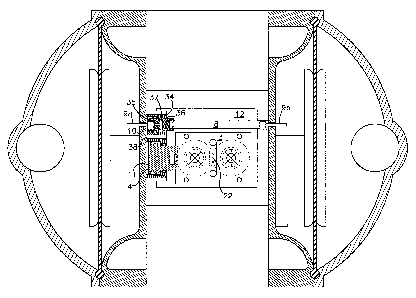Une partie des informations de ce site Web a été fournie par des sources externes. Le gouvernement du Canada n'assume aucune responsabilité concernant la précision, l'actualité ou la fiabilité des informations fournies par les sources externes. Les utilisateurs qui désirent employer cette information devraient consulter directement la source des informations. Le contenu fourni par les sources externes n'est pas assujetti aux exigences sur les langues officielles, la protection des renseignements personnels et l'accessibilité.
L'apparition de différences dans le texte et l'image des Revendications et de l'Abrégé dépend du moment auquel le document est publié. Les textes des Revendications et de l'Abrégé sont affichés :
| (12) Brevet: | (11) CA 2159798 |
|---|---|
| (54) Titre français: | VANNE PILOTE A VANNE AUXILIAIRE PNEUMATIQUE |
| (54) Titre anglais: | MECHANICAL SHIFT, PNEUMATIC ASSIST PILOT VALVE |
| Statut: | Durée expirée - au-delà du délai suivant l'octroi |
| (51) Classification internationale des brevets (CIB): |
|
|---|---|
| (72) Inventeurs : |
|
| (73) Titulaires : |
|
| (71) Demandeurs : |
|
| (74) Agent: | NORTON ROSE FULBRIGHT CANADA LLP/S.E.N.C.R.L., S.R.L. |
| (74) Co-agent: | |
| (45) Délivré: | 2004-12-07 |
| (22) Date de dépôt: | 1995-10-03 |
| (41) Mise à la disponibilité du public: | 1996-04-12 |
| Requête d'examen: | 2002-10-01 |
| Licence disponible: | S.O. |
| Cédé au domaine public: | S.O. |
| (25) Langue des documents déposés: | Anglais |
| Traité de coopération en matière de brevets (PCT): | Non |
|---|
| (30) Données de priorité de la demande: | ||||||
|---|---|---|---|---|---|---|
|
Une valve auxiliaire pneumatique reçoit une pression d'air fourni constante afin de fournir un soutien pneumatique permettant de déplacer la valve pilote, éliminant ainsi les faux signaux agissant sur la tige de déclenchement. De plus, la conception permet de garantir que la valve pilote a été complètement déplacée avant le renversement du diaphragme.
A pneumatic assist valve receives constant air pressure from supply air to provide the pneumatic assist to shift the pilot, eliminating false signals acting on the trip rod and the design also assures the pilot has completely shifted before diaphragm reversal occurs.
Note : Les revendications sont présentées dans la langue officielle dans laquelle elles ont été soumises.
Note : Les descriptions sont présentées dans la langue officielle dans laquelle elles ont été soumises.

2024-08-01 : Dans le cadre de la transition vers les Brevets de nouvelle génération (BNG), la base de données sur les brevets canadiens (BDBC) contient désormais un Historique d'événement plus détaillé, qui reproduit le Journal des événements de notre nouvelle solution interne.
Veuillez noter que les événements débutant par « Inactive : » se réfèrent à des événements qui ne sont plus utilisés dans notre nouvelle solution interne.
Pour une meilleure compréhension de l'état de la demande ou brevet qui figure sur cette page, la rubrique Mise en garde , et les descriptions de Brevet , Historique d'événement , Taxes périodiques et Historique des paiements devraient être consultées.
| Description | Date |
|---|---|
| Inactive : Périmé (brevet - nouvelle loi) | 2015-10-03 |
| Inactive : TME en retard traitée | 2009-10-20 |
| Lettre envoyée | 2009-10-05 |
| Inactive : CIB de MCD | 2006-03-12 |
| Inactive : CIB de MCD | 2006-03-12 |
| Accordé par délivrance | 2004-12-07 |
| Inactive : Page couverture publiée | 2004-12-06 |
| Inactive : Taxe finale reçue | 2004-09-14 |
| Préoctroi | 2004-09-14 |
| Lettre envoyée | 2004-07-30 |
| Un avis d'acceptation est envoyé | 2004-07-30 |
| Un avis d'acceptation est envoyé | 2004-07-30 |
| Inactive : Approuvée aux fins d'acceptation (AFA) | 2004-07-12 |
| Inactive : Dem. traitée sur TS dès date d'ent. journal | 2002-11-07 |
| Lettre envoyée | 2002-11-07 |
| Inactive : Renseign. sur l'état - Complets dès date d'ent. journ. | 2002-11-07 |
| Toutes les exigences pour l'examen - jugée conforme | 2002-10-01 |
| Exigences pour une requête d'examen - jugée conforme | 2002-10-01 |
| Modification reçue - modification volontaire | 2002-10-01 |
| Demande publiée (accessible au public) | 1996-04-12 |
Il n'y a pas d'historique d'abandonnement
Le dernier paiement a été reçu le 2004-09-21
Avis : Si le paiement en totalité n'a pas été reçu au plus tard à la date indiquée, une taxe supplémentaire peut être imposée, soit une des taxes suivantes :
Les taxes sur les brevets sont ajustées au 1er janvier de chaque année. Les montants ci-dessus sont les montants actuels s'ils sont reçus au plus tard le 31 décembre de l'année en cours.
Veuillez vous référer à la page web des
taxes sur les brevets
de l'OPIC pour voir tous les montants actuels des taxes.
Les titulaires actuels et antérieures au dossier sont affichés en ordre alphabétique.
| Titulaires actuels au dossier |
|---|
| THE ARO CORPORATION |
| INGERSOLL-RAND COMPANY |
| Titulaires antérieures au dossier |
|---|
| NICHOLAS, JR. KOZUMPLIK |
| RICHARD K. GARDNER |